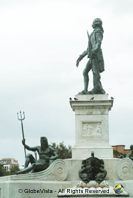Captain Arthur Phillip Fountain

Public Art: Captain Arthur Phillip Fountain
Sculptor: © Achille Simonetti (1838-1900) with assistance from sculptor James White.
Date: The fountain was unveiled on the 22nd June, 1897.
Location: In the Royal Botanic Gardens near the intersection of Macquarie Street and Shakespeare Place, Sydney, Australia.
Cast : Florence, Italy, by F.Galli.
Commission: Sir Henry Parkes commissioned the fountain at a cost of £13,000 ( the costliest of its kind at the time).
Description: The 15.24 m (50ft) high fountain features a marble pedestal for which the bronze 4.5m (15ft) statue Captain Phillips adorns. The rectangular pedestal features three reliefs of Justice, Patriotism and Education. Below the pedestal are the reclining bronze figures of Neptune (navigation), Agriculture, Cyclops (mining) and Commerce. But wait there is more, between the figures are paired dolphins separated by four marble consoles embelished with bronze plaques of Aboriginal people. And last but no least the four giant marble clam shells featuring four bronze prows of ships which feed the water into the white marble basins.
Inscription:
Captain Arthur Phillip, R.N.
First Governor of NSW
1788 – 1792
This monument was unveiled by
the Rt. Hon. Viscount Hampden
– 19th Governor on the 22nd
June, 1897.
Sixtieth year of the reign
of Her Majesty Queen Victoria
The Controversy : Hard to imagine this ornate memorial fountain having any controversy (I jest) . What was suppose to be a naturalistic interpretation became a hodge podge of both realistic and classical, thanks to too many interfering politicians.
To say the Captain Arthur Phillips Fountain became a nightmare for Simonetti would be an understatement. All seemed straightforward enough, on 18th of October 1889 Simonetti was commissioned by his friend and neighbour Sir Henry Parkes to construct an elaborate monument to honour Captain Arthur Phillips. The project was expected to last 4 years but it ended up being nearly a decade before it was unveiled. Simonetti, at the time, was a modelling instructor at the school of the NSW Academy of Art.
All was going according to plan until, in 1891, Sir George Richard Dibbs replaced Parkes and promptly delayed the project for a year. Then came the suggestion by Sir Julian Salomans and E. L. Montefiore that the supporting figures be changed from realistic to classical. Finally, in November 1893 Simonetti was able to travel to Italy to supervize the the bronze castings by Messrs Galli Bros, of Florence and the creation of the Carrara marble pedestal and basins in Genoa by Coriolano Fontana.
The Captain Arthur Phillips Fountain was erected in the Royal Botanical Gardens in 1897, by the Governor of New South Wales, Viscount Hampden, following the devastating fire which destroyed the Garden Palace and left a city in mourning. The fountain and sculpture was erected in celebration of the Diamond Jubilee of Queen Victoria’s Reign with a less than enthusiastic response. Yes, poor Simonetti, who suffered nearly a decade of pain, thanks to both political and aesthetic debates, was in the end pressured by both lovers of allegorical and naturalistic sculptures, to produce an ungainly combination of the two.
Brief History of Captain Arthur Phillips: So who was this Captain? He was appointed Governor of New South Wales, the first European colony on the Australian continent, and was the founder of the site which is now the city of Sydney. Here is a really short history lesson, when Captain Arthur Phillip arrived in Botany Bay (First Fleet), on 18 January 1788, following eight months at sea, he was none too amused with the location recommended by Joseph Banks. The bay had inadequate anchorage and inadequate water supply for the 11 ships and hundreds of disgruntled passengers (and livestock), so he set out with a party of officers in a small boat to find a more suitable location. They eventually found the perfect harbour and Phillip christened it Sydney Cove, after the British Home Secretary, Thomas Townshend, Lord Sydney, in recognition of Lord Sydney’s role in issuing the charter authorising Phillip to establish a colony. Phillip was the first New South Wales Governor from 26th January 1788 until 10th December,1792.
Crazy Facts: The Greek portico was not added until the 1930s.
Sad Facts: I have just done a little bit of rummaging and I have uncovered a sad little fact. Poor old Captain Phillip’s bones are missing! Yes indeed. The remains of the founder of Sydney, Australia, have been lost by the Church of England, and no one knows the location to this day. Bad enough he was laid to rest in St Nicholas Church, Bathampton, BUT to be mislaid as well. Reminds me of the sad old tale of Sir Captain James Stirling. Just dreadful. Geoffrey Robertson Q.C. has vowed to locate the bones of our “national treasure” and return them to Australia. I shall keep you informed.
Magnificent fountain not many Sydney siders know its there. It’s kind of tucked away from the walking paths so people miss it